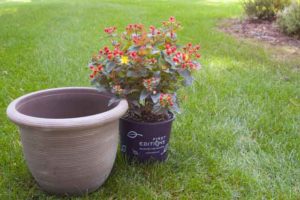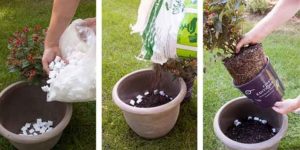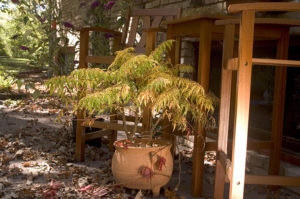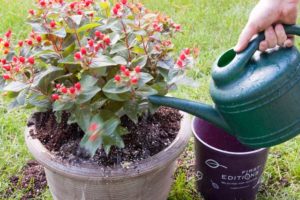There are many flowering and foliage shrubs that will thrive in containers and will become a focal point for the patio or in the garden. Planting shrubs in containers is also great because you get to try plants that you may not be able to grow due to hardiness, lighting conditions, or due to soil issues. Why limit your patio containers to geraniums? First Editions has a wide array of container-ready plants.
If you’d like to try container gardening, here are a few tips:

Select a container that suits the style of your garden and has the capacity to allow the roots to fill in for the specific variety you chose to plant.
Make sure it has proper drainage. If the container doesn’t have a drainage hole, drill a hole or find a container that has one already.

Layer the bottom of the container with broken terracotta or something else you have on hand; packing peanuts are a great household option. This will reduce the amount of soil that will run through the drainage holes and will keep the roots from being damaged by overwatering.
Use your favorite potting soil to fill the rest of the container. Typically soils with a lot of compost and slow release fertilizer will work best. If the potting media does not include fertilizer, mix in a handful of controlled-release fertilizer granules
Set the container off the ground just slightly using bricks or something else to keep your patio stain-free.

Some great container planting options are roses, bittersweet, weigela and even Tiger Eyes® sumac.
If you live in a northern climate and have zone envy of southern gardeners that can grow butterfly bush, gardenia and crape myrtle, this is a great solution to try it in the north. Pair these plants with annuals for a decorative container for the warm months.

Containers need regular watering, even after heavy rain, as shrubs have large root systems that take up a lot of water. In hot or dry weather they may need watering once or twice a day.
If you see the plants in your containers begin to lose their color or vigor, additional nutrition may be necessary, especially in times of heavy feeding. Use a water-soluble fertilizer in these cases during summer.

More often than not, wintering shrubs over in containers can be tricky, but not impossible. Find a cool location such as a three-season porch, a cool basement or garage for your shrubs in containers once they have gone dormant (when they lose their leaves in fall). Make sure to keep the container slightly hydrated during the winter months and hold off on the fertilizer until the snow melts outdoors, typically around March or April.
If you don’t want to overwinter your container, simply discard it and buy fresh the next spring. In other words, treat the container plants like an annual and enjoy the chance to plant something new next year!